Avertro just turned one. These are some of the real moments from our first year.
5th September 2019
Tank Stream Labs. Photo: Ian Yip
Antler representative: “Alright, Ian and Roman. Who’s going to do the driving on the laptop?”
Me: “Roman can. CTO’s job.”
We laughed. There we were, sitting in a meeting room on level 8 at Tank Stream Labs within the Sydney Startup Hub.
8.03 is a big room next to the kitchen, bar, and pool table. It has a long row of windows, a large whiteboard, a projector, and a long table. While it could easily fit 10 people, there were only three of us in that room. It was the only meeting room available during the chosen time slot.
In hindsight, it seemed appropriate. Formally starting a company in the heart of the place we’d gone through the Antler program together, and that we would come to call our office.
Roman clicked through the pages and typed while we all answered the questions together.
Antler representative: “Ok, all done. Time to pay the company registration fees. Who’s doing that?”
Roman: “Ian can. CEO’s job.”
Team member #1
We had money in the bank: Antler’s investment in us. Now we had to put it to good use. Together, we had to convince the first person to come on the journey with us. To solve the problems we were so passionate about addressing for the industry.
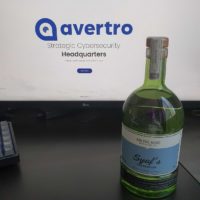
Syaf’s gin Photo: Syaf Djamil
Of course, we were only starting out, which meant doing everything ourselves. I spent countless hours on LinkedIn searching for the right person.
4:07pm, 11th September 2019: Job opportunity to work in a cybersecurity startup
“Hi Syafrudin, Not sure if you’re currently open to opportunities, but we’re an early-stage startup looking for people to help build out our product. Your experience looks to be aligned with the type of person we’d like to work with. If you’re open to having a discussion, please let me know. Best regards, Ian, CEO, Avertro”
Syaf joined us on the 24 September, 2019, and he has been fantastic. In fact, he’s just got to his 1-year anniversary with us. We’re hoping for many more years to come, obviously.
Pilots
Me: “Hi John, it’s Ian. Yeah, no, I don’t work for that company anymore.”
John: “Why not? What happened? That looked like an awesome role!”
Me: “Oh, it was. But I felt compelled to solve a problem that no one else was addressing properly. So, I teamed up with my co-founder to build a company to do exactly that.”
John: “Oh, wow. That sounds great. How can I help?”
Me: “We’d like to learn from you. While I understand the problem from the many conversations I’ve had, and through having to literally solve it for organisations manually, there’s nothing like speaking to people who are living and breathing it daily to learn and figure out how we can do it properly.”
John: “Ok, that makes sense. Sure, happy to help. What do you need me to do?”
Me: “Would you be willing to speak with us for an hour initially and answer a bunch of discovery questions? And then if you’re still willing, meet us regularly as we iterate on the problem and potential ways to solve the various aspects of the challenges you face?”
John: “Sounds like fun. Definitely. Count me in!”
This is an illustrative example. There is no “John”. It’s an amalgamation of many conversations I had in late 2019.
They didn’t all go like this. But for the most part, everyone I asked said “yes”. Some were willing to meet regularly, while others could only give up their time occasionally.
The people who were most helpful, met with us at least fortnightly, some weekly. These turned into our pilot customers the moment we had an alpha release of the Avertro platform.
We started out with a set of Q&A style meetings, progressed to hand-drawn mock ups, whiteboard squiggles, flow charts, and eventually, proper diagrams. I also bought lots of coffee for people.
Every single person that was part of this has become someone I will always pick the phone up for whenever they call. Someone I will always respond to immediately if I’m able to. Someone who will always respond to me when I try to reach them. Someone I will always help should they ask me.
While I’m thankful for all the time they’ve given up for us, it’s the strong relationships and friendships built that I treasure more. In the interest of privacy, I will not name any of you. But if you’re reading this and the above scenario sounds like one of the conversations we had last year, you know I’m talking about you. Thank you.
The “one more thing” moment
“You’ve done this type of thing many times before,” I told myself. This was true, but there’s always a healthy dose of nerves.
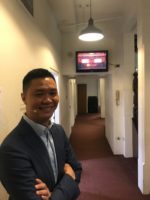
Getting ready to pitch at Demo Day. Photo: Lara Solomon
“You’re up next, get ready, ” I was told.
Mental monologue: “Showtime. Let’s go. Walk up the stairs. One step at at time. Be deliberate. Don’t trip. Don’t trip. Don’t trip. Be calm. Breathe.”
*Deep breath*
*Applause*
“Breathe. Don’t rush it.”
I looked out at 2,000 eyes trained on me in the grandeur of Sydney’s Town Hall. I steadied myself. Stood up straight, but relaxed. Game on.
It was silent now. Dark, but not too dark. I could see each person’s distinct silhouette, which meant I could connect with each and every person out there by looking at them, just like the presentation coaches tell you to.
Bright lights and cameras trained on me. I had everyone’s focused attention, in this iconic landmark. Town Hall’s Grand Organ as my backdrop, the largest in the world when it was built in 1890 and described as the ‘finest organ ever built by an English organ builder’.
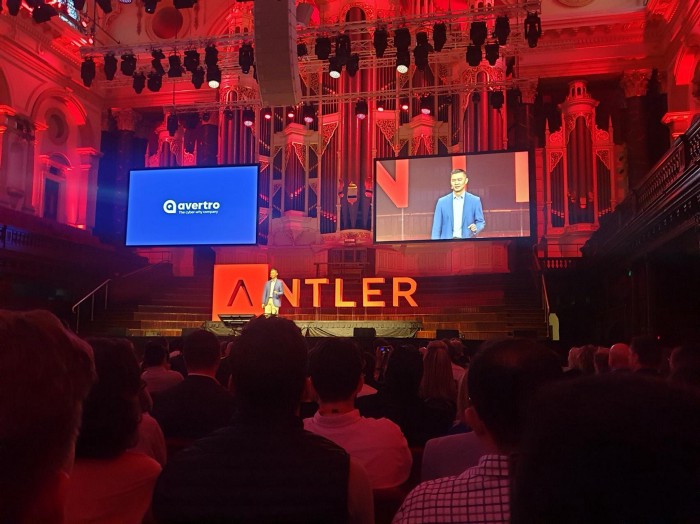
Pitch time! Photo: Sharon Lu
Everything felt as it should be. There were 4,000 additional eyes watching online. This was the moment. Our two-month-old rocket pointed into the stratosphere.
Ignition. 5, 4, 3, 2, 1.
“Take a mental snapshot, you need to remember this moment, ” I thought to myself.
“I feel like my whole career has been one long training course, leading me to this point. Standing in front of you this evening. Because this, ladies and gentlemen, this, is what I’m supposed to be doing.”
I paused deliberately for a few seconds. The audience remained silent. This was it, the heart of the pitch. I needed to make the audience understand why I cared so much about this.
“Leading Avertro,” I continued.
Pause. Survey. Be present in that moment. Mental mic-drop.
I felt like I’d executed the heck out of my Antler Demo Day pitch. Rehearsing that thing 1,000 times had paid off.

In that moment, we all believe we’re Steve Jobs. We all want our “one more thing” moment to leave the audience with. Those who plan well, script it in.
Learning the fundraising shuffle
I had over 20 meetings with venture capitalists and angel investors on the back of the Antler Demo Day pitch. We’d generated buzz, and people wanted to speak with us.
But did they want to invest in us? We thought they would. Did we want their investment? Maybe. Maybe not. We definitely wanted to get to the point where we could say “we don’t need your investment yet,” should we decide it was the right call.
I’m sure every entrepreneur in my position would think the same. We have to be optimists. We must believe. If we don’t, neither will they.
“You’re too early for us.”
“We don’t invest in your industry.”
“We don’t believe we can add value.”
“Keep us updated, because we’d love to support you in later rounds.”
“How can we help?”
“If I can introduce you to someone, just ask.”
“Feel free to reach out if you need feedback.”
We persisted and maintained our faith. At the very least, we were building investment pipeline and needed to start conversations and relationships.
“Yeah, we’re probably too early.”
“Ok. I’ll keep you informed.”
“Sure, we’d definitely like to maintain the relationship.”
We didn’t raise money immediately after Antler Demo Day because we decided to stop dancing. I’d learned early in the process that it wasn’t the right time for us.
The Australian venture ecosystem needed us to show them more proof. The truth is, Australian investors are extremely risk-averse compared to other parts of the world.
For the industry we’re in (cybersecurity) they are even more afraid because almost none of them understand it. And those who do typically only invest in companies at later stages. i.e. Series A and beyond.
Still, the process was an immensely valuable set of lessons that served us well in the months to come.
Customer #1
Customer: “I’m going to be in Sydney for two days. I only have time for a breakfast meeting, so feel free to pick a place.”
Me: “Ok sure. I’ll put it in the meeting invite.”
The breakfast meeting
I was 10 minutes early, and selected a cosy well-lit table inside.
15 minutes later…
Me (via text): “Got a table inside, whenever you get here.”
Customer (via text): “I’ve been here for 30 minutes. Thought I’d get here early to eat.”
Me (via text): “I don’t see you.”
Customer (via text): “I’m sitting outside.”
Me (thinking to myself): “Crap. I thought I looked outside on the way in.”
Me (via text): “No worries. I’ll find you.”
5 minutes later…
Me: “There you are. Looks like you’ve finished eating. More coffee then?”
Customer: “Yep, most definitely.”
10 minutes later…
Customer: “You’re definitely solving a problem that most organisations have to deal with. It’s certainly something we’re trying to do better, and if you can help us, that’d be fantastic. Let’s walk through the MVP one more time next week. If it does everything you say it does, we’re in.”
Me: “Don’t worry. It does. Just tell me when you’re available and I’ll send you the meeting invite.”
Before the world completely changed, the Avertro team used to take a daily afternoon trip to Starbucks on the corner of Margaret and York Streets in Sydney to get our sugar hit.
Going to Starbucks daily meant a well-earned break and walk. As team activities went, it was a nice change of pace from the frenetic speed we usually run at.
My phone rang.
Me: “Hey, how’s it going?”
Customer: “Check your email. You should have a purchase order.”
Me: “Oh. My. God. That. Is. Awesome. Thank you so much. Really. This is the most significant moment in the history of Avertro thus far.”
Customer: “Great. So, are we your first customer? Are we? We are, aren’t we.”
Me: “Yes. Yes, you are. Thank you so much. Thank you. I’ll get this processed in our system and we’ll get you onboarded ASAP.”
Me (to the team): “Team, we’re going to the bar after work. Drinks are on me.”
Cyber Startup School
4am wake up call. I remember thinking to myself that it was ok, because it’s what a founder does. It’s what we do for the cause. On this occasion, it was the first of the weekly 4am wake up calls I’d be enduring every Tuesday morning for the next four months.
Luggage, check. Laptop bag, check. Wallet, check. Phone, check. The notification on my phone told me that my Uber driver had arrived. I was no stranger to this routine. It’s one I’ve auto-piloted my way through for years. Thank goodness for that. It felt completely normal to me, other than the 4am start.
The plane arrived into Melbourne late, and I was stressed about not getting to Stone & Chalk in time. Yeah I know, as a seasoned traveller, I should have planned better.
I couldn’t take my eyes off the Uber app for the whole journey into the CBD. It felt like I was watching a game. And it was the most riveting game I’d ever seen. Estimated arrival time vacillated between 8:50am and 9:15am. “I’m supposed to be there at 9am damn it,” I kept repeating to myself in my head.
Me (via Slack): “Sorry, I might be a little late. The plane didn’t get in on time.”
9:05am. 5 minutes late, not too bad. Straight to the meeting room.
CyRise representative: “You made it! Don’t worry, we haven’t started yet. All good. How’d you get here?”
Me: “Uber.”
CyRise representative: “The bus to Southern Cross Station is actually faster. You should take that next week.”
Years of corporate travel had set my auto-pilot travel tendencies to Taxis and Ubers. It didn’t even cross my mind to take the bus. But I changed that habit, starting with the trip back to the airport a few days later.
After all, I was in school again. This was day one of cyber startup school. This was CyRise. We’d beaten countless other startups to be here. For that, we had to be proud. We were now an Antler portfolio company, and a CyRise portfolio company. The only company in the world able to lay claim to that truth.
Pandemic
The CyRise program adapted to the pandemic by going 100% remote from mid-March. This meant at least that I wouldn’t need to do the 4am thing every Tuesday any longer.
At Avertro, we decided to do so around the same time. We spent a week in the office coming to terms with how things would change, but I made the decision that week for the safety of the team that we were to be fully remote until further notice.
We have remained fully remote since, although we still maintain an official presence at the Sydney Startup Hub because we (mostly me) do need to get into the office from time-to-time.
The hardest part during this period was in determining what our pandemic strategy needed to be. I wrote a draft document, which we then discussed and iterated on as a team.
This was our official policy at the time:
- Work from home until further notice.
- Avoid overly-populated areas and large groups.
- Be personally responsible; self-isolate as much as possible.
- Keep personally informed of the situation.
- Only be in the office if there is a good business reason.
It remains our policy more than six-months later.
Writing the policy was the easy part. As a business, we had to decide what we would do, and how we would communicate it to the team, stakeholders, and customers. This is what we said:
- We have a well-defined product roadmap and our execution plan is independent of having additional external feedback for the moment, due to our designed-thinking approach and large number of discussions with people and customers to date. In short, we know what we need to build over the next 9 months.
- We have enough of a cash runway to execute as a team through the crisis.
- We will scale office requirements down.
- We will reduce the salaries of the founders.
- The positive takeaway from this crisis is that our product capabilities will be vastly superior when the world emerges from the current situation.
- Our pipeline remains healthy, and we are in a good position to resume regular sales activities when the market is ready.
We decided that our focus through mid-2020 would be on:
- Product development.
- Continuing remote conversations with current customers, pilot customers, and design partners.
- Go-to-market planning, with a view to execute on that plan when we emerge from the global crisis.
Most importantly, each member of the team had to:
- Be accountable.
- Show leadership.
- Be professionals.
Ultimately, we decided to switch gears to focusing on the product, doubled-down on learning about the cybersecurity challenges people were still facing, and deeply understanding how the pandemic had changed things for them.
Accelerating
Antler checks in with their portfolio companies regularly. On this occasion, we decided to talk about the road ahead, particularly given the uncertainty for all businesses as a result of the pandemic.
Me: “I know conventional wisdom states we need to slow down and save money. We’ve reduced the costs of non-essential items like office space, but we actually need to go faster by growing the team. The more people we speak to, the more we believe we are solving the right problems. We just need to get more capabilities into the platform faster to meet their demands. What would you say if we decided to fundraise? What if I also put my money where my mouth is by personally investing in the round?”
Antler representative: “It’s not easy to raise funds right now, but not impossible. A show of faith like that from you will help. If you really want to do this, and it sounds like you’re doing it for the right reasons, we will support your efforts.”
And so began our real fundraising efforts. I reached out to all the investors I’d spoken with before, some for advice, some to gauge their interest in the round. Antler ran a series of webinars showcasing portfolio companies, and had me pitch at one of them. I did the angel investment circuit as well.
Looking back at that exercise, I had conversations with or pitched to over 100 people. To be clear, it doesn’t mean I had 100 separate conversations or pitches; some sessions had multiple people in attendance.
Antler was instrumental in helping us secure our lead investor. I’d known the team at Black Nova Group for some time, given they are very much part of the Antler network. They’ve always believed in us as a team. Now, the timing was right for them to officially back us by jumping into the round first.
Once that happened, things became much easier. A few angel investors committed, thanks to “not having to be the first one in”. Antler also participated in the round themselves. And then, our third venture firm, SpringCapital, joined the coalition. We were in fact, over-subscribed in the end and had to leave money on the table.
The key piece of advice many experienced folks gave us through the process once we’d secured our first few commitments in the round was: “take exactly the right amount of money you need. Not a cent more.” So, we did.
Motivation
We successfully closed a round of investment to do exactly what we needed; go faster. And we did it at a time when almost everyone was saying it was impossible to do. We deserved to take a breath. To pause, and reflect.
And we did, only for a moment. It’s extremely important for sanity’s sake to celebrate the wins, especially when running a startup. But we knew we had to go even faster now.
Raising funds is great. But it also means we have more people to answer to. One of our angel investors said this to me as he was committing to us:
“I’m not investing in your company. I’m investing in you based on my belief that you will be successful.”
It’s humbling. People have given us their hard-earned money because they believe in me. It’s also a lot of personal pressure. But it’s pressure I relish. The best use pressure to empower themselves.
To do better. To be world class. To succeed.
I choose to use it as daily motivation to work hard and prove them right.
Traction
We’ve put the investment to good use, having doubled the team over the past few months, mostly in engineering. Our product roadmap is aggressive, and achievable.
The number of commercial discussions over the past few months has doubled. In fact, the third quarter of 2020 saw a significant increase in business for us.
Cyber risk does not disappear during a pandemic. We’ve always known that. It’s just taken organisations time to be comfortable with the new normal, and get back to business.
Our customers believe in us. Our investors believe in us. Most importantly, we believe in us.
- Ian Yip is the CEO of Avertro, a venture-backed cybersecurity software company.
- Avertro CyberHQ is the strategic cybersecurity headquarters that helps leaders manage the business of cyber, explain cybersecurity to executives, forecast outcomes, right-size spend, and validate strategy so leaders can optimise the use of external assistance and prove they are doing cyber right.
- This post first appeared on Medium. You can read the original here.











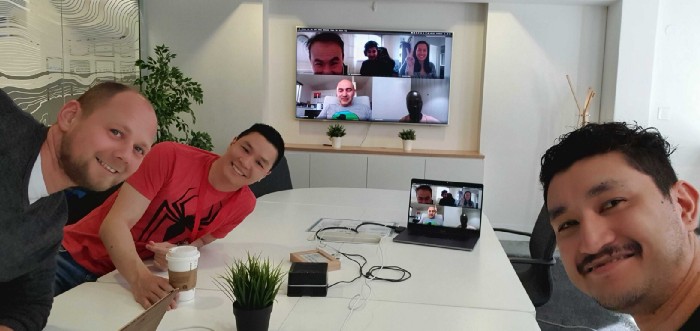
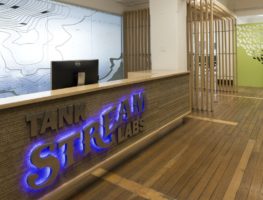








Trending
Daily startup news and insights, delivered to your inbox.